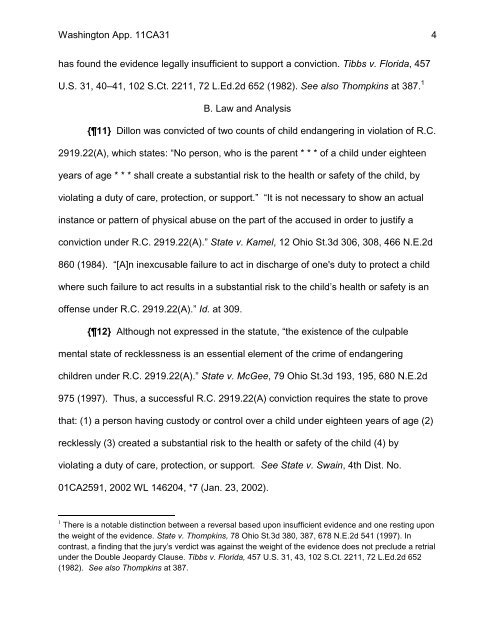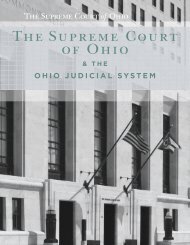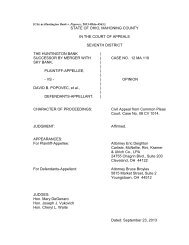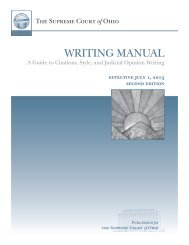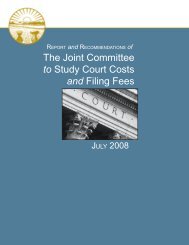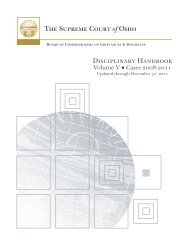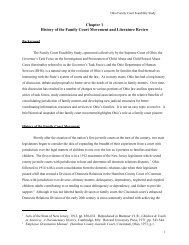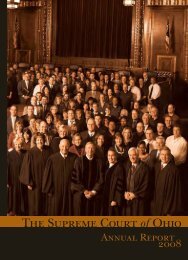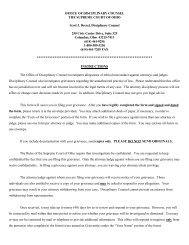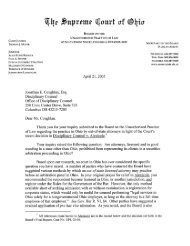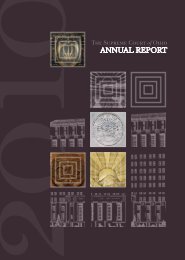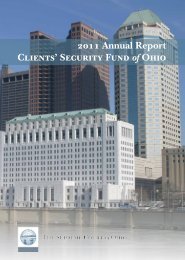State v. Dillon - Supreme Court - State of Ohio
State v. Dillon - Supreme Court - State of Ohio
State v. Dillon - Supreme Court - State of Ohio
Create successful ePaper yourself
Turn your PDF publications into a flip-book with our unique Google optimized e-Paper software.
Washington App. 11CA31 4<br />
has found the evidence legally insufficient to support a conviction. Tibbs v. Florida, 457<br />
U.S. 31, 40–41, 102 S.Ct. 2211, 72 L.Ed.2d 652 (1982). See also Thompkins at 387. 1<br />
B. Law and Analysis<br />
{11} <strong>Dillon</strong> was convicted <strong>of</strong> two counts <strong>of</strong> child endangering in violation <strong>of</strong> R.C.<br />
2919.22(A), which states: “No person, who is the parent * * * <strong>of</strong> a child under eighteen<br />
years <strong>of</strong> age * * * shall create a substantial risk to the health or safety <strong>of</strong> the child, by<br />
violating a duty <strong>of</strong> care, protection, or support.” “It is not necessary to show an actual<br />
instance or pattern <strong>of</strong> physical abuse on the part <strong>of</strong> the accused in order to justify a<br />
conviction under R.C. 2919.22(A).” <strong>State</strong> v. Kamel, 12 <strong>Ohio</strong> St.3d 306, 308, 466 N.E.2d<br />
860 (1984). “[A]n inexcusable failure to act in discharge <strong>of</strong> one's duty to protect a child<br />
where such failure to act results in a substantial risk to the child’s health or safety is an<br />
<strong>of</strong>fense under R.C. 2919.22(A).” Id. at 309.<br />
{12} Although not expressed in the statute, “the existence <strong>of</strong> the culpable<br />
mental state <strong>of</strong> recklessness is an essential element <strong>of</strong> the crime <strong>of</strong> endangering<br />
children under R.C. 2919.22(A).” <strong>State</strong> v. McGee, 79 <strong>Ohio</strong> St.3d 193, 195, 680 N.E.2d<br />
975 (1997). Thus, a successful R.C. 2919.22(A) conviction requires the state to prove<br />
that: (1) a person having custody or control over a child under eighteen years <strong>of</strong> age (2)<br />
recklessly (3) created a substantial risk to the health or safety <strong>of</strong> the child (4) by<br />
violating a duty <strong>of</strong> care, protection, or support. See <strong>State</strong> v. Swain, 4th Dist. No.<br />
01CA2591, 2002 WL 146204, *7 (Jan. 23, 2002).<br />
1 There is a notable distinction between a reversal based upon insufficient evidence and one resting upon<br />
the weight <strong>of</strong> the evidence. <strong>State</strong> v. Thompkins, 78 <strong>Ohio</strong> St.3d 380, 387, 678 N.E.2d 541 (1997). In<br />
contrast, a finding that the jury’s verdict was against the weight <strong>of</strong> the evidence does not preclude a retrial<br />
under the Double Jeopardy Clause. Tibbs v. Florida, 457 U.S. 31, 43, 102 S.Ct. 2211, 72 L.Ed.2d 652<br />
(1982). See also Thompkins at 387.


